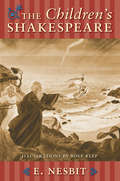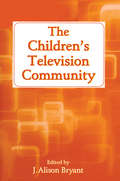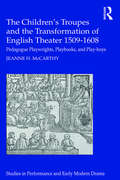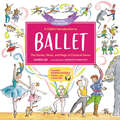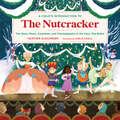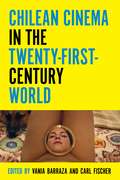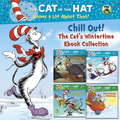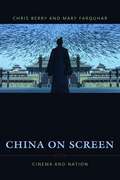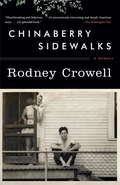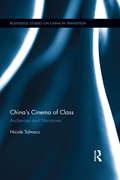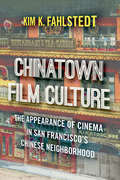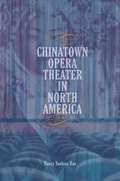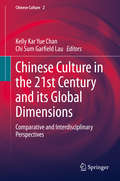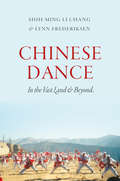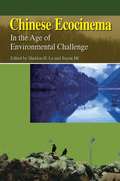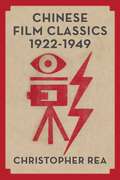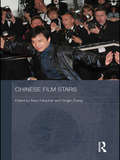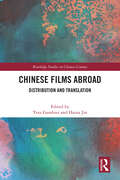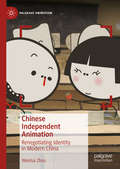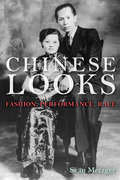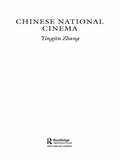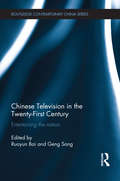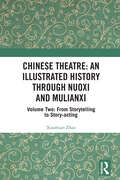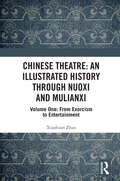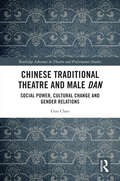- Table View
- List View
The Children's Shakespeare
by Edith NesbitThe acclaimed children&’s author shares vibrant retellings of the Bard&’s timeless tales in this classic, illustrated collection for young readers. As both a writer and a mother, E. Nesbit wanted an engaging way to share the great works of Shakespeare with children. In The Children&’s Shakespeare, she adapted eleven of his plays—including Hamlet, Twelfth Night, A Midsummer Night&’s Dream, and others—into accessible stories that creatively capture all the essential elements. The Children&’s Shakespeare offers an ideal introduction to these works, simply told yet preserving their wit, humor, emotion, and drama. In E. Nesbit's gifted hands, these stories emerge with all the charm and grace of the very best fairy tales. Written in modern English and each no more than ten pages in length, the eleven plays featured in this volume afford children the opportunity to discover the magic of Shakespeare for themselves
The Children's Television Community (Routledge Communication Series)
by J. Alison BryantThe Children’s Television Community presents a cutting-edge analysis of the children’s television community—the organizations, major players, and approaches to programming—and gives an overview of the history, current state, and future of children’s programming. Leading children’s television professionals and distinguished academicians come together in this volume to take a distinctive behind-the-scenes look at how children’s television is created, programmed, and sold. This thought-provoking work emphasizes the various actors whose creative, financial, political, and critical input go into children’s television, and addresses advocacy for children’s television from multiple approaches. By blending these diverse perspectives, editor J. Alison Bryant offers readers a comprehensive picture of children’s television. Highlights include:* a community level approach to understanding children’s television;* perspectives from colleagues in various aspects of the media industry; and* an eye-opening analysis of how decision-making affects what children are exposed to through television. The Children’s Television Community is highly informative for educators, industry professionals, and practitioners in media, developmental psychology, and education.
The Children's Troupes and the Transformation of English Theater 1509-1608: Pedagogue, Playwrights, Playbooks, and Play-boys (Studies in Performance and Early Modern Drama)
by Jeanne McCarthyThe Children’s Troupes and the Transformation of English Theater 1509–1608 uncovers the role of the children’s companies in transforming perceptions of authorship and publishing, performance, playing spaces, patronage, actor training, and gender politics in the sixteenth century. Jeanne McCarthy challenges entrenched narratives about popular playing in an era of revolutionary changes, revealing the importance of the children’s company tradition’s connection with many early plays, as well as to the spread of literacy, classicism, and literate ideals of drama, plot, textual fidelity, characterization, and acting in a still largely oral popular culture. By addressing developments from the hyper-literate school tradition, and integrating discussion of the children’s troupes into the critical conversation around popular playing practices, McCarthy offers a nuanced account of the play-centered, literary performance tradition that came to define professional theater in this period. Highlighting the significant role of the children’s company tradition in sixteenth-century performance culture, this volume offers a bold new narrative of the emergence of the London theater.
A Child's Introduction to Ballet: The Stories, Music, and Magic of Classical Dance (Child's Introduction Series)
by Laura LeeThis enchanting introduction to the wonderful world of ballet has been updated to include a removable poster and access to 25 downloadable music tracks. Young dancers have fallen in love with this charming, illustrated exploration of the world's great ballets. Featuring twenty-five famous and beloved pieces such as Swan Lake, The Nutcracker, Peter and the Wolf and Fancy Free, these stories bring iconic performances to life, and inspire readers to listen and dance along to the music that has made them enduring classics. Woven into these tales is a captivating history of ballet, filled with information and profiles of the world's greatest dancers, choreographers, and composers. Young readers will also enjoy fun facts and dancing how-tos all while listening to excerpts of classical music. Also included is a removable, fold-out poster depicting the five positions of ballet.
A Child's Introduction to the Nutcracker: The Story, Music, Costumes, and Choreography of the Fairy Tale Ballet (A Child's Introduction Series)
by Heather AlexanderBallet enthusiasts of all ages will delight in the magical story of The Nutcracker and the magnificent ballet it inspired in this enchanted book packed with colorful illustrations, fun facts, history, music, and the love of dance. Whether The Nutcracker is your first ballet experience or you&’re already a master dancer, everything you love and want to know about this special, sugar-spun, snow-dusted ballet can be found in these delightful pages. Follow The Nutcracker as it makes its way from page to stage to become the world&’s most popular holiday ballet. Learn all about the dazzling steps, spins, and jumps choreographed by Petipa, Ivanov, and Balanchine, and meet the famed composer Tchaikovsky. Special sections highlight some of the most famous dancers and companies that have brought the performance and the magic of this ballet to life.Packed with charming illustrations showcasing the beautiful costumes and lavish sets, plus removable poster for you to color, A Child&’s Introduction to the Nutcracker lets you to enjoy this magical ballet all year round!
Chilean Cinema in the Twenty-First-Century World (Contemporary Approaches to Film and Media Series)
by María Paz Peirano Carolina Urrutia Neno Camilo Trumper Paola Lagos Labbé Jonathan Risner Moisés Park María Angélica Franken Arturo Márquez-Gómez Vania Barraza Mónica Ramón Ramón Ríos Carl Fischer Claudia Bossay María Constanza Vergara Reyes María Helena RuedaFocusing on films from Chile since 2000 and bringing together scholars from South and North America, Chilean Cinema in the Twenty-First-Century World is the first English-language book since the 1970s to explore this small, yet significant, Latin American cinema. The volume questions the concept of "national cinemas" by examining how Chilean film dialogues with trends in genre-based, political, and art-house cinema around the world, while remaining true to local identities. Contributors place current Chilean cinema in a historical context and expand the debate concerning the artistic representation of recent political and economic transformations in contemporary Chile. Chilean Cinema in the Twenty-First-Century World opens up points of comparison between Chile and the ways in which other national cinemas are negotiating their place on the world stage. The book is divided into five parts. "Mapping Theories of Chilean Cinema in the World" examines Chilean filmmakers at international film festivals, and political and affective shifts in the contemporary Chilean documentary. "On the Margins of Hollywood: Chilean Genre Flicks" explores on the emergence of Chilean horror cinema and the performance of martial arts in Chilean films. "Other Texts and Other Lands: Intermediality and Adaptation Beyond Chile(an Cinema)" covers the intermedial transfer from Chilean literature to transnational film and from music video to film. "Migrations of Gender and Genre" contrasts films depicting transgender people in Chile and beyond. "Politicized Intimacies, Transnational Affects: Debating (Post)memory and History" analyzes representations of Chile’s traumatic past in contemporary documentary and approaches mourning as a politicized act in postdictatorship cultural production. Intended for scholars, students, and researchers of film and Latin American studies, Chilean Cinema in the Twenty-First-Century World evaluates an active and emergent film movement that has yet to receive sufficient attention in global cinema studies.
Chill Out! The Cat's Wintertime Ebook Collection: A Reindeer's First Christmas; New Friends for Christmas; A Long Winter's Nap; Flight of the Penguin (Pictureback(R))
by Joe Mathieu Aristides Ruiz Tish RabeCurl up and chill out with this winter-themed omnibus including four ebooks based on the hit PBS Kids' TV show The Cat in the Hat Knows a Lot About That! With two based on the PBS Kids' holiday special The Cat in the Hat Knows a Lot About Christmas! (A Reindeer's First Christmas and New Friends for Christmas), and two based on the TV show (A Long Winter's Nap--a story about hibernation), and Flight of the Penguin (a story about--what else?--penguins), this is a perfect holiday gift that can be enjoyed long beyond the holidays!
China on Screen: Cinema and Nation (Film and Culture Series)
by Christopher Berry Mary Ann FarquharIn China on Screen, Chris Berry and Mary Farquhar, leaders in the field of Chinese film studies, explore more than one hundred years of Chinese cinema and nation. Providing new perspectives on key movements, themes, and filmmakers, Berry and Farquhar analyze the films of a variety of directors and actors, including Chen Kaige, Zhang Yimou, Hou Hsiao Hsien, Bruce Lee, Jackie Chan, Maggie Cheung, Gong Li, Wong Kar-wai, and Ang Lee. They argue for the abandonment of "national cinema" as an analytic tool and propose "cinema and the national" as a more productive framework. With this approach, they show how movies from China, Hong Kong, Taiwan, and the Chinese diaspora construct and contest different ideas of Chinese nation—as empire, republic, or ethnicity, and complicated by gender, class, style, transnationalism, and more. Among the issues and themes covered are the tension between operatic and realist modes, male and female star images, transnational production and circulation of Chinese films, the image of the good foreigner—all related to different ways of imagining nation. Comprehensive and provocative, China on Screen is a crucial work of film analysis.
Chinaberry Sidewalks
by Rodney CrowellFrom the acclaimed musician comes a tender, surprising, and often uproarious memoir about his dirt-poor southeast Texas boyhood. The only child of a hard-drinking father and a Holy Roller mother, Rodney Crowell was no stranger to bombast from an early age, whether knock-down-drag-outs at a local dive bar or fire-and-brimstone sermons at Pentecostal tent revivals. He was an expert at reading his father's mercurial moods and gauging exactly when his mother was likely to erupt, and even before he learned to ride a bike, he was often forced to take matters into his own hands. He broke up his parents' raucous New Year's Eve party with gunfire and ended their slugfest at the local drive-in (actual restaurants weren't on the Crowells' menu) by smashing a glass pop bottle over his own head. Despite the violent undercurrents always threatening to burst to the surface, he fiercely loved his epilepsy-racked mother, who scorned boring preachers and improvised wildly when the bills went unpaid. And he idolized his blustering father, a honky-tonk man who took his boy to see Hank Williams, Jerry Lee Lewis, Carl Perkins, and Johnny Cash perform live, and bought him a drum set so he could join his band at age eleven. Shot through with raggedy friends and their neighborhood capers, hilariously awkward adolescent angst, and an indelible depiction of the bloodlines Crowell came from, Chinaberry Sidewalks also vividly re-creates Houston in the fifties: a rough frontier town where icehouses sold beer by the gallon on paydays; teeming with musical venues from standard roadhouses to the Magnolia Gardens, where name-brand stars brought glamour to a place starved for it; filling up with cheap subdivisions where blue-collar day laborers could finally afford a house of their own; a place where apocalyptic hurricanes and pest infestations were nearly routine. But at its heart this is Crowell's tribute to his parents and an exploration of their troubled yet ultimately redeeming romance. Wry, clear-eyed, and generous, it is, like the very best memoirs, firmly rooted in time and place and station, never dismissive, and truly fulfilling.
China's Cinema of Class: Audiences and Narratives (Routledge Studies on China in Transition)
by Nicole TalmacsChina’s commercial film industry can be used as a map to understand how class is interwoven into the imaginations that inform and influence social change in Chinese society. Film consumption is important in this process, particularly for young adult urbanites that are China’s primary commercial cinema patrons. This book investigates the web between the representation of class themes in Chinese film narratives, local audience reception to these films, and the socialisation of China’s contemporary class society. Bringing together textual analyses of narratives from five commercially exhibited films: Let the Bullets Fly (Jiang: 2010), Lost on Journey (Yip: 2011), Go Lala Go! (Xu: 2011), House Mania (Sun: 2011) and The Piano in the Factory (Zheng: 2011); and the reception of 179 Chinese audiences from varying class positions, it investigates the extent to which fictional narratives inform and reflect current class identities in present-day China. Through group discussions in Beijing, Hangzhou, Nanjing, Lanzhou and Taiyuan, the author searches for audiences beyond major cities that are typically the focus of film consumption studies in China. As such, the book reveals not only how deeply and widespread the socialisation of China’s class society has become in the imaginations of Chinese audiences, but also what appears to be a preference of both audiences and filmmakers for the continuation of China’s new class society. Revealing the extent to which cinema continues to play a key role in the socialisation of class structures in contemporary Chinese society, this book will be important for students and scholars of Chinese Studies, Film Studies, Communication Studies, as well as observers of China’s film industry.
Chinatown Film Culture: The Appearance of Cinema in San Francisco’s Chinese Neighborhood
by Kim K. FahlstedtChinatown Film Culture provides the first comprehensive account of the emergence of film and moviegoing in the transpacific hub of San Francisco in the early twentieth century. Working with materials previously left in the margins of grand narratives of history, Kim K. Fahlstedt uncovers the complexity of a local entertainment culture that offered spaces where marginalized Chinese Americans experienced and participated in local iterations of modernity. At the same time, this space also fostered a powerful Orientalist aesthetic that would eventually be exported to Hollywood by San Francisco showmen such as Sid Grauman. Instead of primarily focusing on the screen-spectator relationship, Fahlstedt suggests that immigrant audiences' role in the proliferation of cinema as public entertainment in the United States saturated the whole moviegoing experience, from outside on the street to inside the movie theater. By highlighting San Francisco and Chinatown as featured participants rather than bit players, Chinatown Film Culture provides an historical account from the margins, alternative to the more dominant narratives of U.S. film history.
Chinatown Opera Theater in North America
by Nancy Yunhwa RaoThe Chinatown opera house provided Chinese immigrants with an essential source of entertainment during the pre “World War II era. But its stories of loyalty, obligation, passion, and duty also attracted diverse patrons into Chinese American communities Drawing on a wealth of new Chinese- and English-language research, Nancy Yunhwa Rao tells the story of iconic theater companies and the networks and migrations that made Chinese opera a part of North American cultures. Rao unmasks a backstage world of performers, performance, and repertoire and sets readers in the spellbound audiences beyond the footlights. But she also braids a captivating and complex history from elements outside the opera house walls: the impact of government immigration policy; how a theater influenced a Chinatown's sense of cultural self; the dissemination of Chinese opera music via recording and print materials; and the role of Chinese American business in sustaining theatrical institutions. The result is a work that strips the veneer of exoticism from Chinese opera, placing it firmly within the bounds of American music and a profoundly American experience.
Chinese Culture in the 21st Century and its Global Dimensions: Comparative and Interdisciplinary Perspectives (Chinese Culture #2)
by Kelly Kar Yue Chan Chi Sum Garfield LauThis book investigates the internationalization of Chinese culture in recent decades and the global dimensions of Chinese culture from comparative and interdisciplinary perspectives. It covers a variety of topics concerning the contemporary significance of Chinese culture in its philosophical, literary and artistic manifestations, including literature, film, performing arts, creative media, linguistics, translations and philosophical ideas. The book explores the reception of Chinese culture in different geographic locations and how the global reception of Chinese culture contrasts with the local Chinese community. The chapters collectively cover gender studies and patriarchal domination in Chinese literature in comparison to the world literature, explorations on translation of Chinese culture in the West, Chinese studies as an academic discipline in the West, and Chinese and Hong Kong films and performances in the global context. The book is an excellent resource for both scholars and students interested in the development of Chinese culture on the global stage in the 21st Century.
Chinese Dance: In the Vast Land and Beyond
by Shih-Ming Li Chang Lynn E. Frederiksen Emily WilcoxAs China becomes increasingly important in world relations, many components of the country's cultural arts remain unknown outside its borders. Shih-Ming Li Chang and Lynn E. Frederiksen's Chinese Dance: In the Vast Land and Beyond undertakes the challenge of discovering the relationship between Chinese dance in its many forms and the cultural contexts of dance within the region and abroad. As a comprehensive resource, Chinese Dance offers students and scholars an invaluable introduction to the subject. It serves as a foundation of common knowledge from which Chinese and English-language communities can begin a cross-cultural conversation about Chinese dance. The text, along with a comprehensive glossary of key terms, gives English-language readers a chance to understand the development of Chinese dance as it is officially articulated by historians and dance scholars in Asia. An online database of video clips, an extensive bibliography, and Web-based appendices provide a broad collection of primary source materials that invite interactive and flexible engagement by a range of users. The inclusion of interviews with Chinese dance practitioners in North America offers a view into the Asian diaspora experience.
Chinese Ecocinema
by Sheldon H. LuThis anthology is the first book-length study of China's environmental condition and ecosystem through the lens of cinema from a non-anthropocentric point of view. By proposing "ecocinema" as a new critical framework, the volume breaks new ground in Chinese and global film studies.
Chinese Film Classics, 1922–1949
by Christopher G. ReaChinese Film Classics, 1922–1949 is an essential guide to the first golden age of Chinese cinema. Offering detailed introductions to fourteen films, this study highlights the creative achievements of Chinese filmmakers in the decades leading up to 1949, when the Communists won the civil war and began nationalizing cultural industries.Christopher Rea reveals the uniqueness and complexity of Republican China’s cinematic masterworks, from the comedies and melodramas of the silent era to the talkies and musicals of the 1930s and 1940s. Each chapter appraises the artistry of a single film, highlighting its outstanding formal elements, from cinematography to editing to sound design. Examples include the slapstick gags of Laborer’s Love (1922), Ruan Lingyu’s star turn in Goddess (1934), Zhou Xuan’s mesmerizing performance in Street Angels (1937), Eileen Chang’s urbane comedy of manners Long Live the Missus! (1947), the wartime epic Spring River Flows East (1947), and Fei Mu’s acclaimed work of cinematic lyricism, Spring in a Small Town (1948). Rea shares new insights and archival discoveries about famous films, while explaining their significance in relation to politics, society, and global cinema. Lavishly illustrated and featuring extensive guides to further viewings and readings, Chinese Film Classics, 1922–1949 offers an accessible tour of China’s early contributions to the cinematic arts.
Chinese Film Stars (Routledge Contemporary China Series)
by Mary FarquharThis volume of original essays fills a significant research gap in Chinese film studies by offering an interdisciplinary, comparative examination of ethnic Chinese film stars from the silent period to the era of globalization. Whereas studies of stars and stardom have developed considerably in the West over the past two decades, there is no single book in English that critically addresses issues related to stars and stardom in Chinese culture. Chinese Film Stars offers exemplary readings of historically, geographically and aesthetically multifaceted star phenomena. An international line up of contributors test a variety of approaches in making sense of discourses of stars and stardom in China and the US, explore historical contexts in which Chinese film stars are constructed and transformed in relation to changing sociopolitical conditions, and consider issues of performance and identity specific to individual stars through chapter-by-chapter case studies. The essays explore a wide range of topics such as star performance, character type, media construction, political propaganda, online discourses, autobiographic narration, as well as issues of gender, genre, memory and identity. Including fifteen case studies of individual Chinese stars and illustrated with film stills throughout, this book is an essential read for students of Chinese film, media and cultural studies.
Chinese Films Abroad: Distribution and Translation (Routledge Studies in Chinese Cinema)
by Yves Gambier Haina JinThis book examines Chinese films made and shown abroad roughly between the 1920s and the 2020s, from the beginning of the international exchange of the Chinese national film industry to the emergence of the concept of soft power.The periodisation of Chinese cinema(s) does not necessarily match the political periods: on the one hand, the technical development of the film industry and the organisation of translation in China, and on the other hand, official relations with China and translation policies abroad impose different constraints on the circulation of Chinese films. This volume deals with the distribution and translation of films from mainland China, Taiwan, Hong Kong, and the Chinese diaspora. To this end, the contributors address various issues related to the circulation and distribution of Chinese films, including co- productions, agents of exchange, and modes of translation. The approach is a mixture of socio- cultural and translational methods. The data collected provides, for the first time, a quantitative overview of the circulation of Chinese films in a dozen foreign countries.The book will greatly interest scholars and students of Chinese cinema, translation studies, and China studies.
Chinese Independent Animation: Renegotiating Identity in Modern China (Palgrave Animation)
by Wenhai ZhouThis study of ‘independent’ animation opens up a quietly subversive and vibrant dimension of contemporary Chinese culture which, hitherto, has not received as much attention as dissident art or political activism. Scholarly interest in Chinese animation has increased over the last decade, with attention paid to the conventional media circle of production, distribution and consumption. The ‘independent’ sector has been largely ignored however, until now. By focusing on distinctive independent artists like Pisan and Lei Lei, and situating their work within the present day media ecology, the author examines the relationship between the genre and the sociocultural transformation of contemporary China. Animation, the author argues, has a special significance, as the nature of the animation text is itself multilayered and given to multiple interpretations and avenues of engagement. Through an examination of the affordances of this ‘independent’ media entity, the author explores how this multifaceted cultural form reveals ambiguities that parallel contradictions in art and society. In so doing, independent animation provides a convenient ‘mirror’ for examining how recent social upheavals have been negotiated, and how certain practitioners have found effective ways for discussing the post-Socialist reality within the current political configuration.
Chinese Looks
by Sean MetzgerFrom yellow-face performance in the 19th century to Jackie Chan in the 21st, Chinese Looks examines articles of clothing and modes of adornment as a window on how American views of China have changed in the past 150 years. Sean Metzger provides a cultural history of three iconic objects in theatrical and cinematic performance: the queue, or man's hair braid; the woman's suit known as the qipao; and the Mao suit. Each object emerges at a pivotal moment in US-China relations, indexing shifts in the balance of power between the two nations. Metzger shows how aesthetics, gender, politics, economics, and race are interwoven and argues that close examination of particular forms of dress can help us think anew about gender and modernity.
Chinese National Cinema (National Cinemas #20)
by Yingjin ZhangThis introduction to Chinese national cinema covers three 'Chinas': mainland China, Hong Kong and Taiwan. Historical and comparative perspectives bring out the parallel developments in these three Chinas, while critical analysis explores thematic and stylistic changes over time. As well as exploring artistic achievements and ideological debates, Yingjin Zhang examines how - despite the pressures placed on the industry from state control and rigid censorship - Chinese national cinema remains incapable of projecting a single unified picture, but rather portrays many different Chinas.
Chinese Television in the Twenty-First Century: Entertaining the Nation (Routledge Contemporary China Series)
by Ruoyun Bai Geng SongThe past two decades witnessed the rise of television entertainment in China. Although television networks are still state-owned and Party-controlled in China, the ideological landscape of television programs has become increasingly diverse and even paradoxical, simultaneously subservient and defiant, nationalistic and cosmopolitan, moralistic and fun-loving, extravagant and mundane. Studying Chinese television as a key node in the network of power relationships, therefore, provides us with a unique opportunity to understand the tension-fraught and , paradox-permeated conditions of Chinese post-socialism. This book argues for a serious engagement with television entertainment. rethinking, It addresses the following questions. How is entertainment television politically and culturally significant in the Chinese context? How have political, industrial, and technological changes in the 2000s affected the way Chinese television relates to the state and society? How can we think of media regulation and censorship without perpetuating the myth of a self-serving authoritarian regime vs. a subdued cultural workforce? What do popular televisual texts tell us about the unsettled and reconfigured relations between commercial television and the state? The book presents a number of studies of popular television programs that are sensitive to the changing production and regulatory contexts for Chinese television in the twenty-first century. As an interdisciplinary study of the television industry, this book covers a number of important issues in China today, such as censorship, nationalism, consumerism, social justice, and the central and local authorities. As such, it will appeal to a broad audience including students and scholars of Chinese culture and society, media studies, television studies, and cultural studies.
Chinese Theatre: Volume Two: From Storytelling to Story-acting
by Xiaohuan ZhaoChinese Theatre: An Illustrated History Through Nuoxi and Mulianxi is the first book in any language entirely devoted to a historical inquiry into Chinese theatre through Nuoxi and Mulianxi, the two most representative and predominant forms of Chinese temple theatre. Volume Two is a continuation of the historical inquiry into Chinese theatre with focus shifted from Mulian storytelling to Mulian story-acting. Thus, this volume traces the historical trajectory of xiqu from Northern dramas to Southern dramas and from elite court theatre to mass regional theatre with pivotal forms and functions of Mulianxi examined, explicated and illustrated in association with the development of corresponding genres of xiqu. In so doing, every aspect of Mulianxi is considered not in the margins of xiqu but in and of itself. While this volume is primarily concerned with Mulianxi, references are also made to other forms of Chinese performing arts and temple theatre, Nuoxi in particular, as Mulianxi has been performed since the twelfth century as, or in company with, Nuoxi, to cleanse the community of evil spirits and epidemic diseases. This is an interdisciplinary book project that is aimed to help researchers and students of theatre history understand the ritual origins of Chinese theatre and the dynamic relationships among myth, ritual, religion and theatre.
Chinese Theatre: Volume One: From Exorcism to Entertainment
by Xioahuan ZhaoChinese Theatre: An Illustrated History Through Nuoxi and Mulianxi is the first book in any language entirely devoted to a historical inquiry into Chinese theatre through Nuoxi and Mulianxi, the two most representative and predominant forms of Chinese temple theatre. With a view to evaluating the role of temple theatre in the development of xiqu or traditional Chinese theatre and drama from myth to ritual to ritual drama to drama, Volume One provides a panoramic perspective that allows every aspect of Nuoxi to be considered, not in the margins of xiqu but in and of itself. Thus, this volume traces xiqu history from its shamanic roots in exorcism rituals of Nuo to various forms of ritual and theatrical performance presented at temple fairs, during community and calendrical festivals or for ceremonial functions over the course of imperial history, and into the twenty-first century, followed by an exploration of the scriptural origins and oral traditions of Mulianxi, with pivotal forms and functions of Nuoxi and Mulian storytelling, examined, explicated and illustrated in association with the development of corresponding genres of Chines performance literature and performing arts. This is an interdisciplinary book project that is aimed to help researchers and students of theatre history understand the ritual origins of Chinese theatre and the dynamic relationships among myth, ritual, religion, and theatre.
Chinese Traditional Theatre and Male Dan: Social Power, Cultural Change and Gender Relations (Routledge Advances in Theatre & Performance Studies)
by Guo ChaoThis book examines male dan, a male actor who performs female roles in Chinese theatre. Through the rise, fall and tenuous survival of male dan in Chinese history, Guo Chao reflects the transformations in the social zeitgeist in China, especially the politics of gender and sexuality. The breadth of this study reflects a diversified set of sources, ranging from classical to contemporary texts (texts of jingju plays, memoirs, collections of notation books) and other commentaries and critical evaluations of dan actors (in both English and Chinese languages), to video and audio materials, films, and personal interviews. This book will be of great interest to students and scholars of East Asian/Chinese studies across the fields of theatre, history, culture, and literature.
